It’s 9.30pm. You just put your child to sleep. Finally, you have your own time to enjoy. You walk out from the bedroom and switch on the TV in the living room. You don’t really care what the TV program is about. But, you are attracted by a TV program on how to teach a child to ride a bike.
It is a kid’s bike commercial. In fact, what caught your attention is the cute and chubby boy who is riding THAT fancy bike like a pro. His mom is so proud of him and she reveals the riding secret-THAT fancy bike-to her friends.
A compelling 30-second commercial with a nice story, features and benefits related to the kid’s bike.
That’s totally persuasive. – You start to reminisce that time when you just learned how to ride a bike as a child and how happy your parents were. Good old days.
After that, you walk to the bedroom and look at your sleeping child: you start to imagine your child riding a bike and you couldn’t resist hugging him for his achievement.
Well, why not teach your child how to ride a bike?
In this post, I’m gonna share with you not only how you could teach your child to ride a bike, but also how to make him enjoy the process.
You may be surprised that you need proper parenting to teach your child how to ride a bike, too.
For this purpose, the process is divided into three phases: before learning, learning and after learning.
Before Learning
1. Motivate your child
You want to make sure your child enjoys riding a bike.
Then, you need to motivate your child rather than forcing him to ride a bike.
A child at his age is creative, adventurous and willing to learn new thing. – So, this is the golden opportunity for him to learn cycling!
For example, on weekends, you could go to the park with a bike with your family. Then, demonstrate him how to ride a bike to stimulate his curiosity.
Observe the reaction of your child. Then, explain to him the fun of riding a bike and answer his questions if any.
Try to encourage him to ride a bike. If he is excited and willing to learn, congratulations!
2. Buy a bike to teach your child to ride a bike
Buy a bike either from physical store or internet.
But, before you make an actual purchase, spend some time with your child to choose the bike.
Since the bike is for your child, try to listen to his preference and opinion on what type of bikes he likes. Then, you can shortlist the bikes based on his preference.
Of course, the price of the shortlisted bikes must be within your budget. If his selection is out of your budget, try to explain to him the reason of choosing a more affordable bike.
In this case, maybe you think you’ll just say “NO” without explanation because your kid is too young to understand the reason.
This is the purpose of explanation. EDUCATE your child from the very beginning on the basic principle. Instill that mindset so that he can apply it in future.
Alright, everything’s good to go. Then, let your child CHOOSE the bike.
3. Assemble the bike

You could opt out of the assembly of the bike. There are two reasons for this.
First reason: to minimize your purchase.
Second reason: You can assemble the bike by yourself.
This is the cool thing about this. Treat it as a family project. – Assemble the bike with your child.
Never underestimate the ability of your child. Your child could be a big helper for you!
Your child doesn’t have to get involved in the dangerous work, such as carry the heavy wheels and assemble the wheels, but he could help you in providing you screw bag, getting you the guidebook, getting you the pedals….
Let him engage with the process of assembling HIS bike. And, don’t forget to acknowledge his effort and contribution in assembling his bike.
4. Name the bike
Alright! Let your child name his bike if he wants to.
Thinking it is silly or naïve because who will name a bike? If this is your thought, then why do you name your pet? – Shouldn’t be the same?
Again, children are creative and imaginative. Sometimes, we need to let go of our adult thinking and think like a child.
Think about it. I bet you have named your special toys when you were a kid. Or, you even had an imaginary friend, right?
Well, why not be “creative” with your child and suggest some funny names to him? After all, he’ll need to decide the name to the bike.
Learning
1. Safety gears and bike condition
Well, I’m pretty sure you also buy the necessary safety gears along with the kid’s bike.
Help him equip the helmet, elbow and knee pads. In addition, explain to your child the importance of having the safety gears.
Just like how we educate them the things what they need to be aware of when they cross the street, say “No” to stranger, etc. – Education on the safety for cycling is equally important.
After that, teach your child to check the condition of the bike. Make sure the saddle is slightly below his hips; let him test the brake lever; and test the wheels while spinning the pedals.
If you think carefully, this is very similar to how we are taught while we learn driving, isn’t it?
See, the education on checking the condition of the bike should be emphasized, so that you child understands about proper bike condition before you start to teach your child to ride a bike.
2. Ride with training wheels
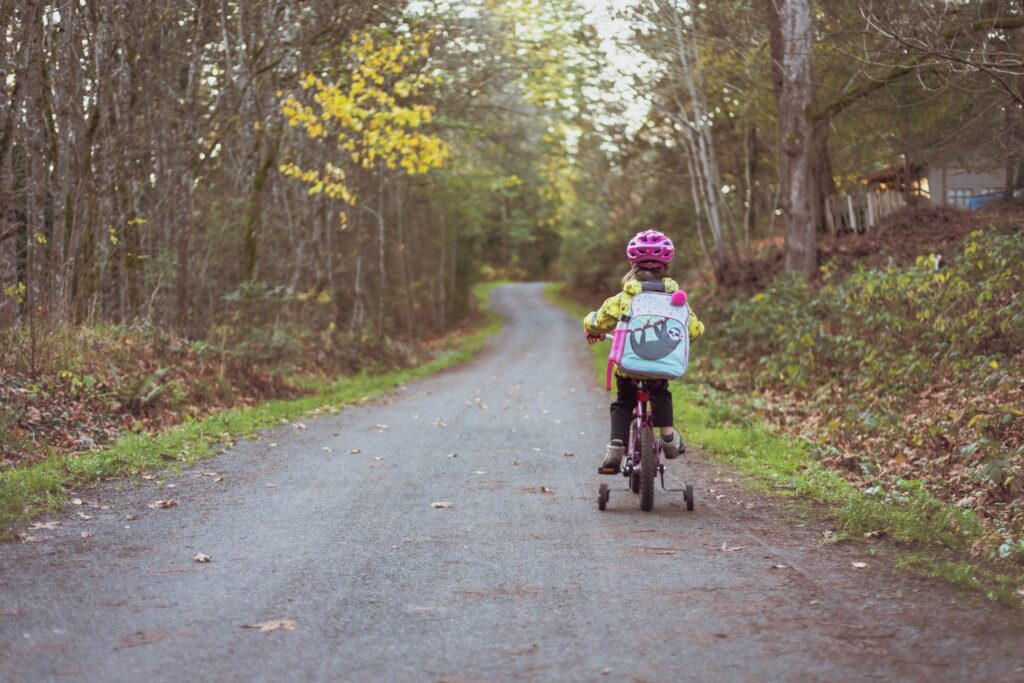
You may skip this step, if you like to.
But here’s a thing. Why don’t you give your child a chance to know how riding a bike FEELS like without worrying about falling down?
At least he gets motivated and is not frustrated by learning all the hard things.
You don’t have to teach him any technical things yet. All you have to do is just to let him pedal on a flat and open space, observe and follow him closely while he pedals.
However, this session shouldn’t be long. – Maybe 30 minutes to 1 hour is enough.
After he is comfortable with this, it is time to let him learn the real thing.
3. Get on the bike and scooting
First, remove the training wheels.
Then, I suggest removing the pedal.
Why?
Because the purpose is to let your child learn about scooting. Unlike adult, if the pedal is there, I’m afraid that your child would have the tendency to start pedaling before he learns about BALANCING.
Teach your child how to mount the bike. Lean the bike towards him, and arch his leg over his bike and sit on the saddle.
His legs should be able to touch the ground. Then, ask him to look FORWARD.
Whilst the bike is not moving yet, you can HOLD one side of the handle bar to provide additional support.
Now, encourage him to push his leg off the ground alternatively. Put your other hand on the back of your child or the saddle and release the hand on the handle bar.
His bike is wobbling. Convince him that is OK and encourage him to continue and keep trying to balance the bike. Don’t release your hand yet because he is still learning how to balance his bike.
Once your child is able to balance the bike, RELEASE your hand and let him fully control the bike.
Then, your child is ready for pedaling.
4. Pedaling
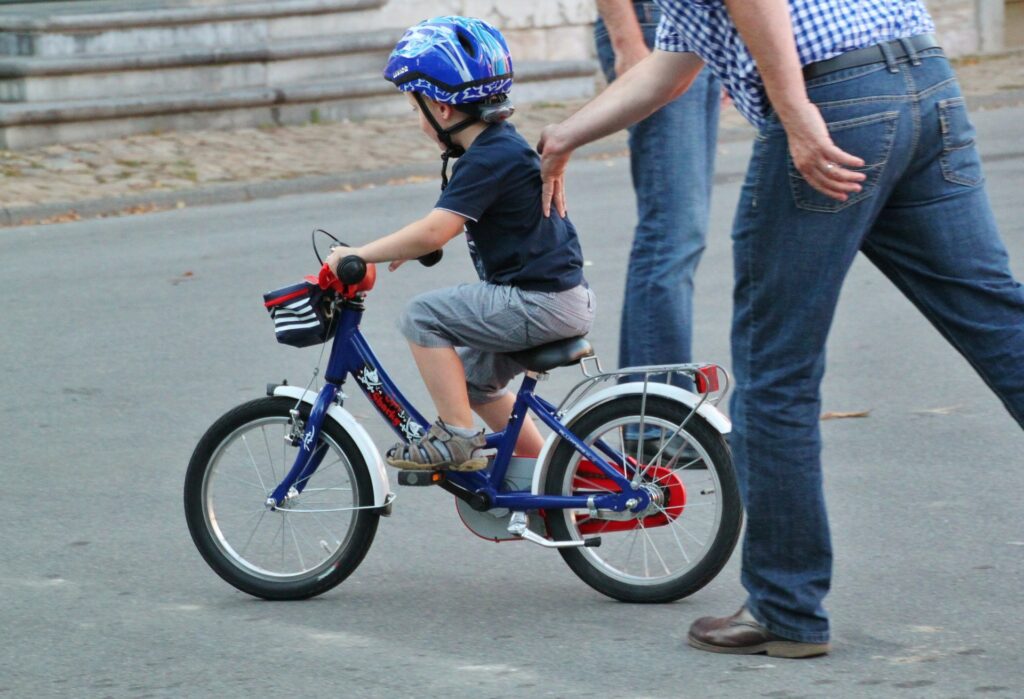
The step is almost the same as scooting, but with the ACTUAL pedaling. – But, this is also the challenging part.
First thing first, re-install the pedal to the bike.
After that, let your child mount the bike and sit on the saddle. Then, teach him to adjust the position of the pedal by pedaling backward.
Let him position one side of the pedal to 2- to 3-o’clock position. Put his foot on the pedal.
Remind him to look FORWARD. Educate him to press the brake lever and put his feet on the ground if he feels he is about to fall down.
Then, it’s time to pedal! Once his bike moves, remind him to use his other foot to pedal as well.
As this time, you should provide additional stability by pressing his back or holding the saddle. Move with the bike.
Reassure him to keep trying to balance his bike.
If he is losing balance, remind him to brake and put his feet on the ground. You could also try to hold the handle bar to prevent your child from falling down.
Only release your hand when your child is able to stabilize the bike while he is pedaling.
But, you have to be PATIENT in this step because your child may not be able to ride a bike in his first session.
5. Praise your child
No matter how big or small the achievement or progress of your child is, always be generous to praise your child.
For example: let him know how much you appreciate his effort in helping you to assemble the bike. Praise him if he could remember the safety measure and the proper bike condition. Praise him for his effort in trying to balance his bike, etc….
Why? Because your child is willing to get out of his comfort zone to learn new things. A small praise or appreciation can enlighten him.
Let’s think from your side. How would you feel if your boss personally says a big “thank you” or writes you a “thank you” letter for your hard work? Do you feel motivated?
We need confirmation on our effort and hard work to be motivated. Same goes to our little children.
Also, avoid expressing frustration and using negative words to your child. For example “why are you so stupid?”. “how many times I have told you this, and you still couldn’t do this?”, “how can you be so forgetful?”.
In fact, negative statements could impact your child’s emotional, cognitive and social development. He may feel worthless, be harsh on himself and even feel low self-esteem.
You know how it feels if those words were spoken to you. So, don’t speak to your child like that if you feel frustrated.
6. Take pictures or record video
Why not making the learning session more interesting by taking pictures or recording a video? You’ll definitely love it when you share the learning moment to your friends and family in the social media.
Be proud of your child, even just learning how to ride a bike. Silly, funny or frustrating, just cherish the moment.
Or, you could even make it more personally by making a traditional photo album. You would think it is unnecessary since we have social media, but saving the pictures in a photo album is exquisite.
Imagine fast forward to 20 or 30 years later, both you and your child could probably have forgotten about this. And, all the memories come back just because you both accidentally flip through the photo album. Nostalgia.
7. Be supportive when your child falls down
Falling down is unavoidable when it comes to learning how to ride a bike. Whilst adults have fear of falling down, the fear may double for your child.
When your child falls down and cries, try to RESIST the urge to lift your child up, unless it is a serious fall.
This is to educate him that falling down is totally fine, and he has to get up by himself and continue to learn.
If your child is still crying and still feels bad about himself, then maybe you can try to kneel down next to him, hold his hand and encourage him to get up with you.
After that, don’t forget to let him know to pick up his own bike too. – Please don’t pick up the bike for your child.
After Learning
1. Let your child carry the bike
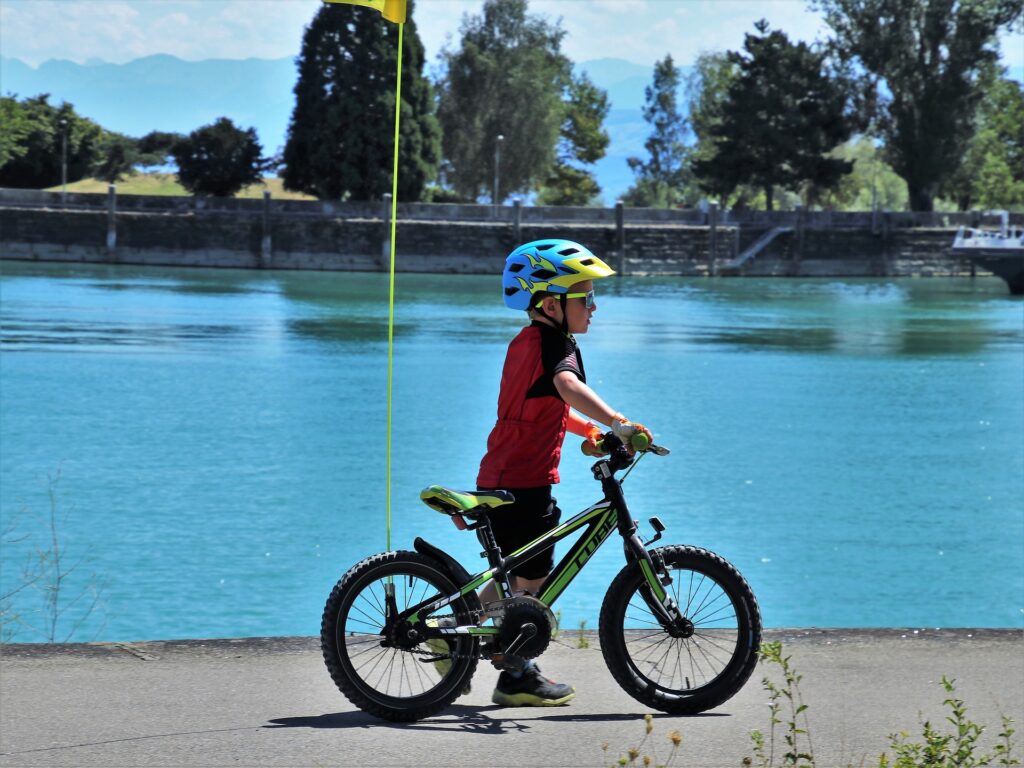
Same goes to picking up his own bike. After the end of the cycling session, educate your child to carry his bike to the destination, say to the car or the garage.
You can also suggest a few places to let him put his bike. Let him decide so that he understands his RESPONSIBILITY to take care of his own bike.
Also, whenever he wants to ride his bike, he has to carry the bike by himself too.
2. Reward your child’s effort
If your child is able to ride a bike after his first learning session, congratulations! – This totally is worth celebrating.
Or, if you child still needs more learning sessions, you can also reward your child’s effort in making a PROGRESS.
To reward your child, you’d probably want to ask your child what he wants to eat. Whether he wants to eat at a restaurant or you could cook for him.
Or, what does he want or want to do? Maybe you could buy him a toy or play his favourite game with him.
It doesn’t matter, as long as your child knows his progress matters.
But, make sure the reward is REASONABLE and not too grand or pricey. – You wouldn’t want to spoil your child by rewarding him a 7-day Europe trip, for instance, for being able to ride a bike, even you afford to.
3. Spend time to practice with your child
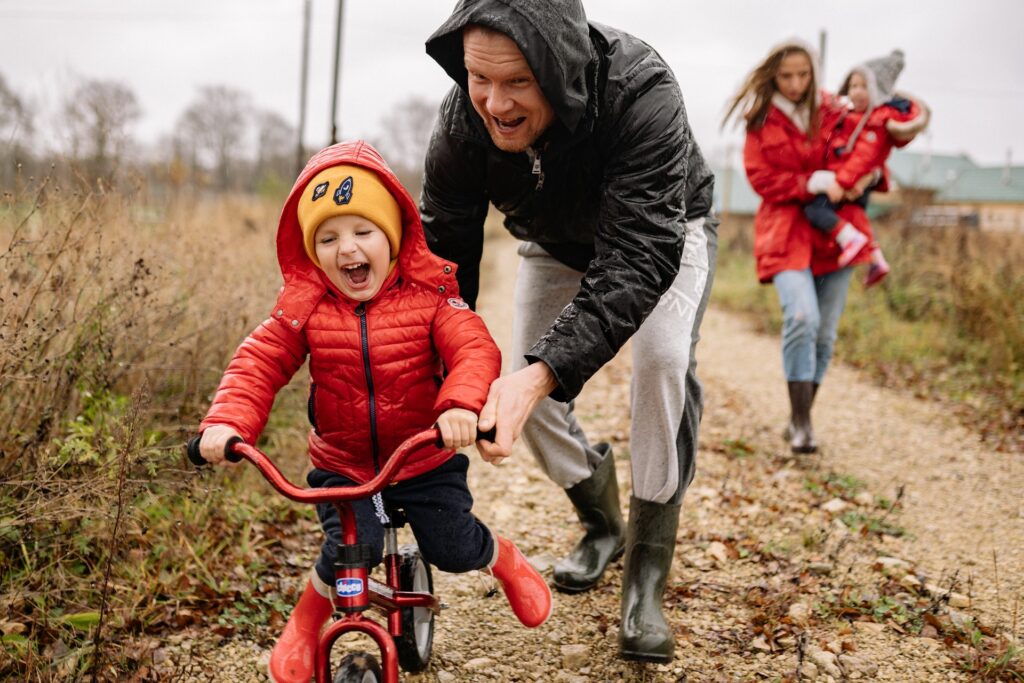
Whether your child is able to ride a bike after his first learning session or not, he still needs practice.
This is a test for you, as a parent, to test your PATIENCE. I believe that you are aware of teaching your child to ride a bike doesn’t end after the first session.
So be prepared to keep repeating the scooting and pedaling phases above.
Sometimes, it is understandable that we expect children to be able to learn fast. Well, we also understand that we might be frustrated if things don’t meet our expectation.
Whenever you feel frustrated, let’s reminisce the moment when your child, as an infant, learned to craw and walk. He didn’t have enough strength to craw and fell so many times when he tried to walk. – Did you complain how long it took? You kept motivating him, right?
Let’s treat riding as a milestone to him. Learn with him, and celebrate with him once he achieves this milestone.
4. Ride with your child
Alright! This is the fun part. Your effort in teaching is rewarded!
Your child is probably very excited to ride his bike after he learned how to ride his bike. He is READY to adventure!
And, it’s time for family bonding moment!
Spare some time, like weekends, to ride the bike with him. Ride in the park, or the pavement along the seaside. Observe how excited he is.
Don’t ride too fast, as you need to slow down to match the speed of your child.
Or, why not having a riding race with your child? – But make sure you don’t outpace him too much. Or, you can let him outpace you. HAHA!
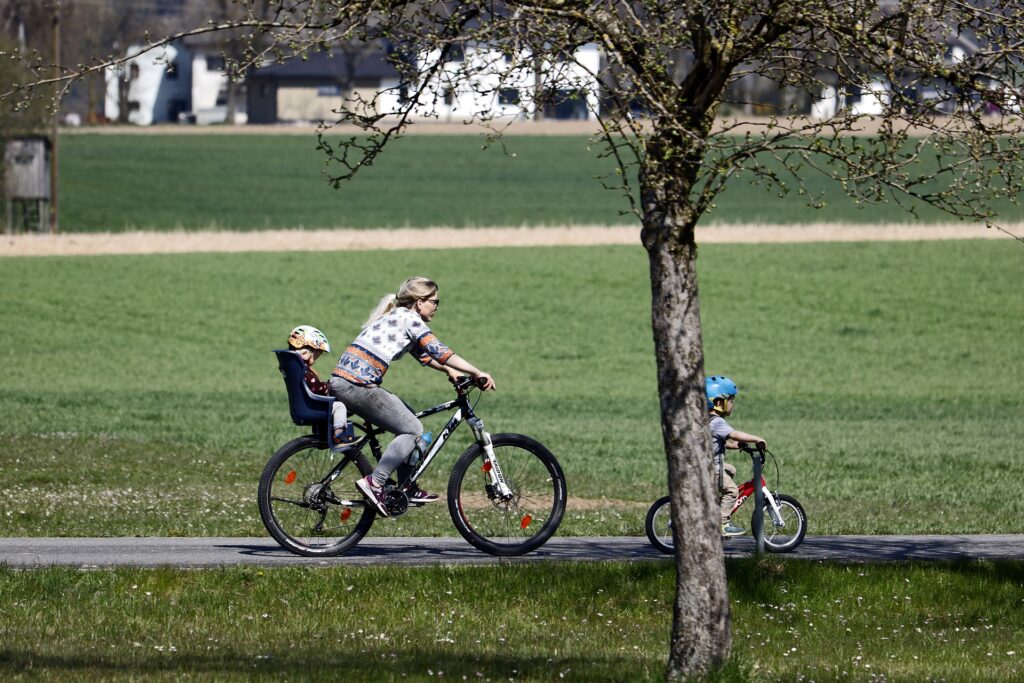
Final Thought
The proper way to teach your child to ride a bike is not merely letting him learn how to ride a bike, but it involves proper parenting to educate your child the proper and necessary things and skill through learning to ride a bike.
Children are like blank papers. They explore and want to learn anything to colour the blank papers. Since parents are the closest people to them, they see us as learning models so they “learn” whatever we show them – both good and bad.
Thus, it is necessary to instill the proper mindset, like explaining to them the importance of riding safety, the necessity to get up after a fall etc, which they could apply them when they grow up. – Talk about the importance of building character!
In fact, this is a perfect chance to teach your child to ride a bike for family bonding. Because it is 2-way learning: your child learns to ride; you learn about patience and improve your parenting skills by observing and understanding your child better.
Relevant posts
